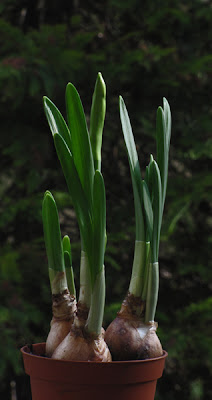Yesterday I got two pots with bulbs from my husband so I thought it was time to write about the technology of forcing bulbs. Though my experiences are not too fat but I have also some knowledge acquired at the Corvinus Horticultural University of Budapest.
Here they are: Narcissus 'Tête-à-Tête' and Tulipa 'Sans Nom' (just kidding, the latter has no name).


At this time of year the flower shops are full of flowering tulips, narcissi and hyacinths, put 2-3 in little pots. These bulbs were forced, namely submitted to strict temperature treatment to flower earlier than usual.
There is a complete technology of forcing: how many weeks in what temperature must be stored the bulbs to mimic the nature in an accelerated rhythm. This depends also on species or cultivar: there are some which are excellent for forcing and others which are not at all for this purpose.
To understand the forcing one must know the life cycle of bulbous plants.
This is what happens in mother Nature and in the garden:
The spring flowering bulbous plants of our temperate zone draw back in early summer. After flowering and seed ripening their leaves and roots die back, this is a surviving strategy during the summer draught and heat or the poor light conditions in deciduous woods. But before withdrawing the new bulb forms for next year. This happens with the help of assimilating leaves, so they must be left alone until yellowing to do their job.
During summer the bulb is apparently resting in the soil, but at this time is the next year's flower initiating. There are precise informations available about the sequence of initiation of the different flower parts and the time and temperature needed for each of them. However, the average temperature needed is 20°C. On a bulb cut in two and painted with ink one can see the formed flower parts with a loupe.
In september (or sometimes later) as the soil temperature decreases and rains fall, the bulb makes new roots. The optimal temperature for this process is 9°C.
BUT in this rooted stage the plant in no way can be forced to flower yet!!! It needs some weeks of even lower temperature (about 5°C) for the bud to form and push itself up to the top of the bulb. Then it is ready to flower in adequate conditions. The time needed to spend in 5°C depends on species or cultivar. And this is the essential condition of forcing! This 9°C and 5°C temperature treatment. Right after the flower parts are initiated (this also can be accelerated with storing at defined temperatures) he bulbs are dry stored at 9°C and then at 5°C for limited time – the minimum time needed for the given species. Than the bulb is ready to flower given higher temperatures. It does not even need to have roots! After the 5°C storing, the bulb must be stored onwards at 2°C, to hinder blooming. For good timing of the flowering is essential to keep to the exact temperatures and times needed during the above treatment.
I've learned this at the Horticultural University.
Now my experiences.
I tried to force bulbs of narcissi without the above temperature treatment for Christmas and January – with no results. I potted them up in September, watered and kept outside until early December. Then took them inside in 20°C and watered. They made leaves, but no flowers. The flower bud was probably not yet completely formed, ready to be born, so the baby flower died in the bulb.
But we can make bulbs without temperature treatment to flower much earlier than usual, that is in March instead of May, for example. They must be potted in September, watered well to make roots and then kept on the dry side during the winter to avoid wet rot. This is rather hard, to find the way between not too dry and not too wet, but it is a matter of paying attention.
Than take it inside in February, firstly in 16°C than in a warmer room, and they will flower. If you take them directly in 20°C room, you must cover them to etiolate, namely the flower stem to grow above the leaves. But be careful, if the temperature too hot the flower wants to open in the bulb already.
Now back to the two (six) plants shown above.
The forcing of dry stored bulbs has a problem (not for the grower but for the customer): the bulbs usually flower almost without roots, so they can not be kept for next years because no new bulb will form.
This time they had roots:
 |
| Narcissi |
 |
| This one had very few, but let's try anyway |
 |
| Tulips |
These roots are very brittle, must be handled with much care. I put them together in a large pot. I will water them and also give some nutrients, rich in K, as I have learned from Ian Young. I hope to have flowers also next year, though not at this time.
Today opened also the first Narcissus flower:
And another day later:






2 comments:
Interesting .. I just purchased Hepatica bulbs from Lowe's .. it's early February in coastal Maine and I'm wondering if I can force these .. do you think?
Hello Sarah, welcome to my blog!
Hepatica is not a bulb, though I reckon that its' "crone" (that is the part of the plant between the roots and the stem) may look like a bulb.
However, now, at the end of the winter I think it can be forced a little, but don't put it in too hot! I think 16°C (60F) would be good and it will flower earlier. But I never tried it!
Post a Comment